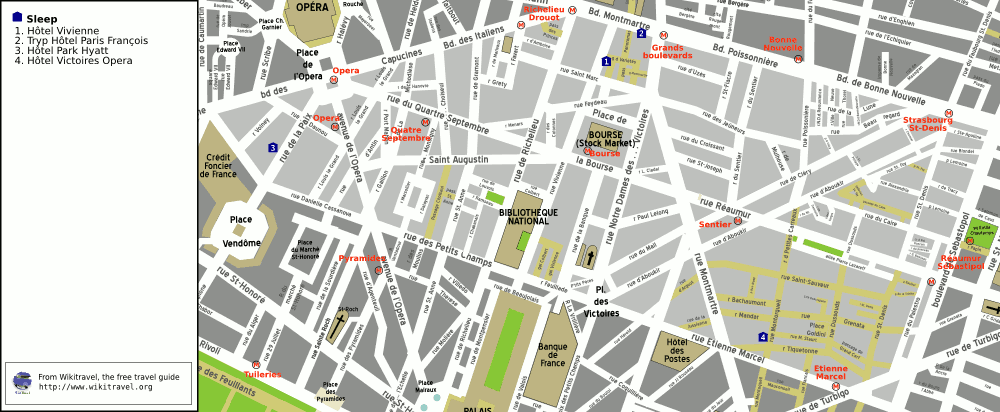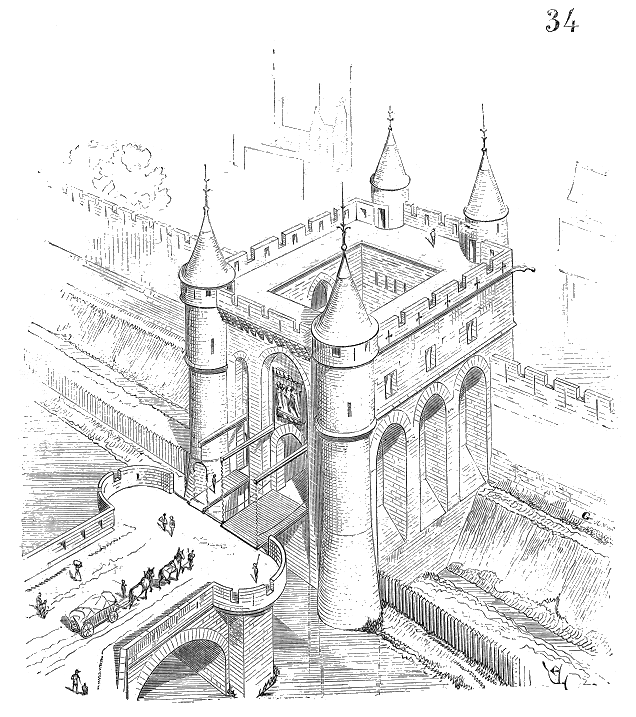|
Strasbourg–Saint-Denis Station
Strasbourg–Saint-Denis () is a station on Line 4, Line 8 and Line 9 of the Paris Métro. Opened in 1908 under the name Boulevard Saint-Denis, it took on its current name in 1931, which refers to Rue Saint-Denis and the Boulevard de Strasbourg. Location The station of Line 4 is located under the Boulevard de Strasbourg while the stations of Lines 8 and 9 are located under the Boulevard de Bonne-Nouvelle. These last two lines cross Line 4 perpendicularly and from below, and which replaced the Louis XIII wall and is in soft ground, which was once the course of the Seine. Line 8 is on the higher level and Line 9 in the lower level. The platforms are at the sides and the box containing the lines and supporting the road above is strengthened by a central wall between the tracks. History The station was opened on 5 May 1908, two weeks after the opening of the first section of Line 4 from Porte de Clignancourt to Châtelet on 21 April 1908. The Line 8 platforms opened on 5 May 193 ... [...More Info...] [...Related Items...] OR: [Wikipedia] [Google] [Baidu] |
2nd Arrondissement Of Paris
The 2nd arrondissement of Paris (''IIe arrondissement'') is one of the 20 arrondissements of the capital city of France. In spoken French, this arrondissement is colloquially referred to as ''deuxième'' (second/the second). It is governed locally together with the 1st, 3rd and 4th arrondissement, with which it forms the 1st sector of Paris. Also known as Bourse, this arrondissement is located on the right bank of the River Seine. The 2nd arrondissement, together with the adjacent 8th and 9th arrondissements, hosts an important business district, centred on the Paris Opéra, which houses the city's most dense concentration of business activities. The arrondissement contains the former Paris Bourse (stock exchange) and several banking headquarters, as well as a textile district, known as the Sentier, and the Opéra-Comique's theatre, the Salle Favart. The 2nd arrondissement is the home of Grand Rex, the largest movie theater in Paris. The 2nd arrondissement is also the home ... [...More Info...] [...Related Items...] OR: [Wikipedia] [Google] [Baidu] |
Samuel Tyszelman
Samuel Tyszelman (born Szmul Cecel Tyszelman; 21 January 1921 – 19 August 1941) was a Jewish Poland, Polish communist who was a member of the French Resistance during World War II (1939-1945). He and another man were arrested and executed for taking part in an anti-German demonstration. That started a series of assassinations and reprisals in which over 500 people were killed. Life Szmul Cecel Tyszelman was born in Puławy, Poland, on 21 January 1921. His family was Jewish. During World War II (1939–1945), he was a member of the French communist resistance organization known as . He was in a group named the , whose members were Jews who had migrated from Eastern Europe in the 1920s and the 1930s. In early August 1941, three of them (Tyzelman, Charles Wolmark and Elie Walach) stole of dynamite from a quarry in the Seine-et-Oise. On 13 August 1941, Tyszelman, known as "Titi", was among a group of 100 young people, male and female, who walked out of the Strasbourg – Saint-Deni ... [...More Info...] [...Related Items...] OR: [Wikipedia] [Google] [Baidu] |
Pointe Du Lac (Paris Métro)
Pointe du Lac station () is a station on Line 8 of the Paris Métro in the commune of Créteil. It is the eastern terminus Terminus may refer to: Ancient Rome *Terminus (god), a Roman deity who protected boundary markers Transport *Terminal train station or terminus, a railway station serving as an end destination *Bus terminus, a bus station serving as an end des ... of the line. History It opened on 8 October 2011 as part of a extension from , with construction having started in 2007. It is the easternmost on the Paris Métro system (not including stations on RER lines) and was also the southernmost one until the opening of the Aéroport d’Orly station in 2024. It is situated to the southeast of Créteil Lake. It is currently the second-newest above-ground station on the Paris Métro, behind Coteaux Beauclair on Line 11. In 2019, the station was used by 2,849,288 passengers making it the 186th busiest of the Métro network, out of 302 stations. In 2020, the ... [...More Info...] [...Related Items...] OR: [Wikipedia] [Google] [Baidu] |
Bonne Nouvelle (Paris Métro)
Bonne Nouvelle () is a station on Lines 8 and 9 of the Paris Métro. The section of both lines from just east of Richelieu – Drouot to west of République was built under the Grand Boulevards, which replaced the Louis XIII wall and is in soft ground, which was once the course of the Seine. The lines are built on two levels, with line 8 on the higher level and line 9 in the lower level. The platforms are at the sides and the box containing the lines and supporting the road above is strengthened by a central wall between the tracks. There is no interconnection between the lines at Bonne Nouvelle, with each level having different accesses to the street; however, passengers may pass between levels in order to make connections. History The station was opened on 5 May 1931 with the extension of Line 8 from Richelieu – Drouot to Porte de Charenton. The Line 9 platforms were opened on 10 December 1933 with the extension of the line from Richelieu – Drouot to Porte de Montre ... [...More Info...] [...Related Items...] OR: [Wikipedia] [Google] [Baidu] |
Balard (Paris Métro)
Balard () is the southwestern Train station, terminus of Paris Métro Line 8, Line 8 of the Paris Métro in the 15th arrondissement of Paris. Since 16 December 2006, it has also been a stop on Île-de-France tramway Lines 3a and 3b, tramway T3a as part of the initial section of the line between Pont du Garigliano and Porte d'Ivry (Paris Métro), Porte d'Ivry. The station is named after Place Balard, itself named after Antoine Jérôme Balard, Antoine-Jérôme Balard (1802-1876), a French chemist and the discoverer of bromine. Among the stations serving the Boulevards of the Marshals, Boulevards des Maréchaux along the City gates of Paris, former gates of Paris, it is the only one not called ''Porte de…'', though it serves the Porte de Sèvres. History The station opened on 27 July 1937 as part of the extension of line 8 from La Motte-Picquet - Grenelle (Paris Métro), La Motte-Picquet - Grenelle, serving as its new south-western terminus. On 3 September 1943, the Royal Air Fo ... [...More Info...] [...Related Items...] OR: [Wikipedia] [Google] [Baidu] |
Château D'Eau (Paris Métro)
A château (, ; plural: châteaux) is a manor house, or palace, or residence of the lord of the manor, or a fine country house of nobility or gentry, with or without fortifications, originally, and still most frequently, in French-speaking regions. Nowadays, a ''château'' may be any stately residence built in a French style; the term is additionally often used for a winegrower's estate, especially in the Bordeaux region of France. Definition The word château is a French word that has entered the English language, where its meaning is more specific than it is in French. The French word ''château'' denotes buildings as diverse as a medieval fortress, a Renaissance palace and a fine 19th-century country house. Care should therefore be taken when translating the French word ''château'' into English, noting the nature of the building in question. Most French châteaux are "palaces" or fine "country houses" rather than "castles", and for these, the word "château" is appropria ... [...More Info...] [...Related Items...] OR: [Wikipedia] [Google] [Baidu] |
Platform Screen Doors
Platform screen doors (PSDs), also known as platform edge doors (PEDs), are used at some train, rapid transit and people mover stations to separate the platform from train tracks, as well as on some bus rapid transit, tram and light rail systems. Primarily used for passenger safety, they are a relatively new addition to many metro systems around the world, some having been retrofitted to established systems. They are widely used in newer Asian and European metro systems, and Latin American bus rapid transit systems. History The idea of platform edge doors dates from as early as 1908, when Charles S. Shute of Boston was granted a patent for "Safety fence and gate for railway-platforms". The invention consisted of "a fence for railway platform edges", composed of a series of pickets bolted to the platform edge, and vertically movable pickets that could retract into a platform edge when there was a train in the station. In 1917, Carl Albert West was granted a patent for " ... [...More Info...] [...Related Items...] OR: [Wikipedia] [Google] [Baidu] |
Side Platform
A side platform (also known as a marginal platform or a single-face platform) is a platform positioned to the side of one or more railway tracks or guideways at a railway station, tram stop, or transitway. A station having dual side platforms, one for each direction of travel, is the basic design used for double-track railway lines (as opposed to, for instance, the island platform where a single platform lies between the tracks). Side platforms may result in a wider overall footprint for the station compared with an island platform, where a single width of platform can be shared by riders using either track. In some stations, the two side platforms are connected by a footbridge or tunnel to allow safe access to the alternate platform. While a pair of side platforms is often provided on a dual-track line, a single side platform is usually sufficient (trains are usually only boarded from one side) for a single-track line. Layout Where the station is close to a level crossing (g ... [...More Info...] [...Related Items...] OR: [Wikipedia] [Google] [Baidu] |
Louis XIV
LouisXIV (Louis-Dieudonné; 5 September 16381 September 1715), also known as Louis the Great () or the Sun King (), was King of France from 1643 until his death in 1715. His verified reign of 72 years and 110 days is the List of longest-reigning monarchs, longest of any monarch in history. An emblem of the Absolutism (European history), age of absolutism in Europe, Louis XIV's legacy includes French colonial empire, French colonial expansion, the conclusion of the Thirty Years' War involving the Habsburgs, and a controlling influence on the Académie royale de peinture et de sculpture, style of fine arts and architecture in France, including the transformation of the Palace of Versailles into a center of royal power and politics. Louis XIV's pageantry and opulence helped define the French Baroque architecture, French Baroque style of art and architecture and promoted his image as absolute ruler of France in the early modern period. Louis XIV began his personal rule of France ... [...More Info...] [...Related Items...] OR: [Wikipedia] [Google] [Baidu] |
Porte Saint-Denis
The Porte Saint-Denis (; ) is a Parisian monument located in the 10th arrondissement, at the site of one of the gates of the Wall of Charles V, one of Paris's former city walls. It is located at the crossing of the Rue Saint-Denis continued by the Rue du Faubourg Saint-Denis, with the Boulevard de Bonne-Nouvelle and the Boulevard Saint-Denis. History The Porte Saint-Denis was originally a gateway through the Wall of Charles V that was built between 1356 and 1383 to protect the Right Bank of Paris. The medieval fortification had two gates and was surmounted with four towers. Additional portcullises defended the outer gate along with a drawbridge and rock-cut ditch. However, with the advent of gunpowder and the development of cannons and bombards, the walls were eventually partly torn down in the 1640s to make way for the larger and more fortified Louis XIII Wall. In the 1670s, the remaining walls of Charles V were entirely demolished when Paris spread beyond the confines ... [...More Info...] [...Related Items...] OR: [Wikipedia] [Google] [Baidu] |





